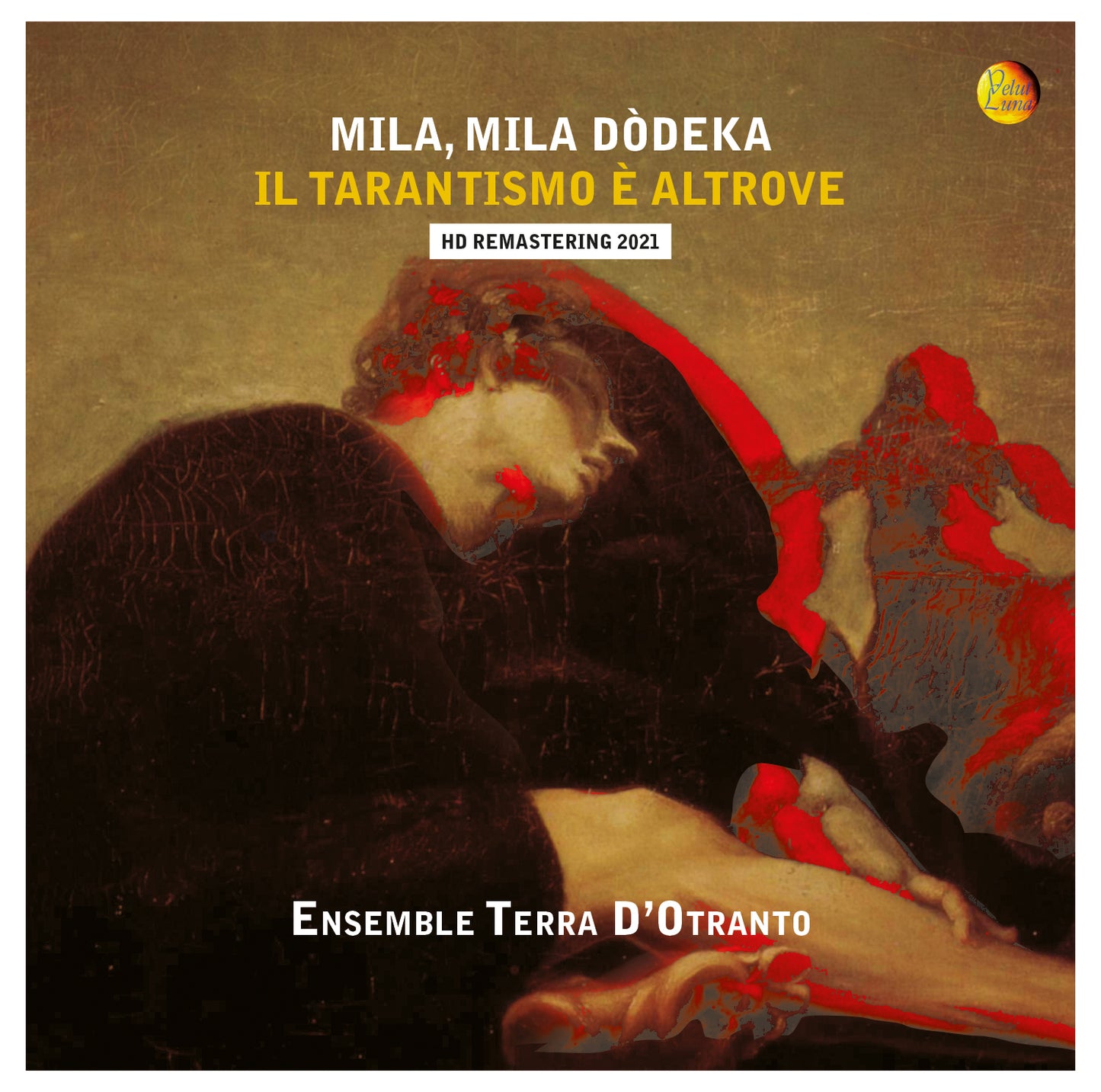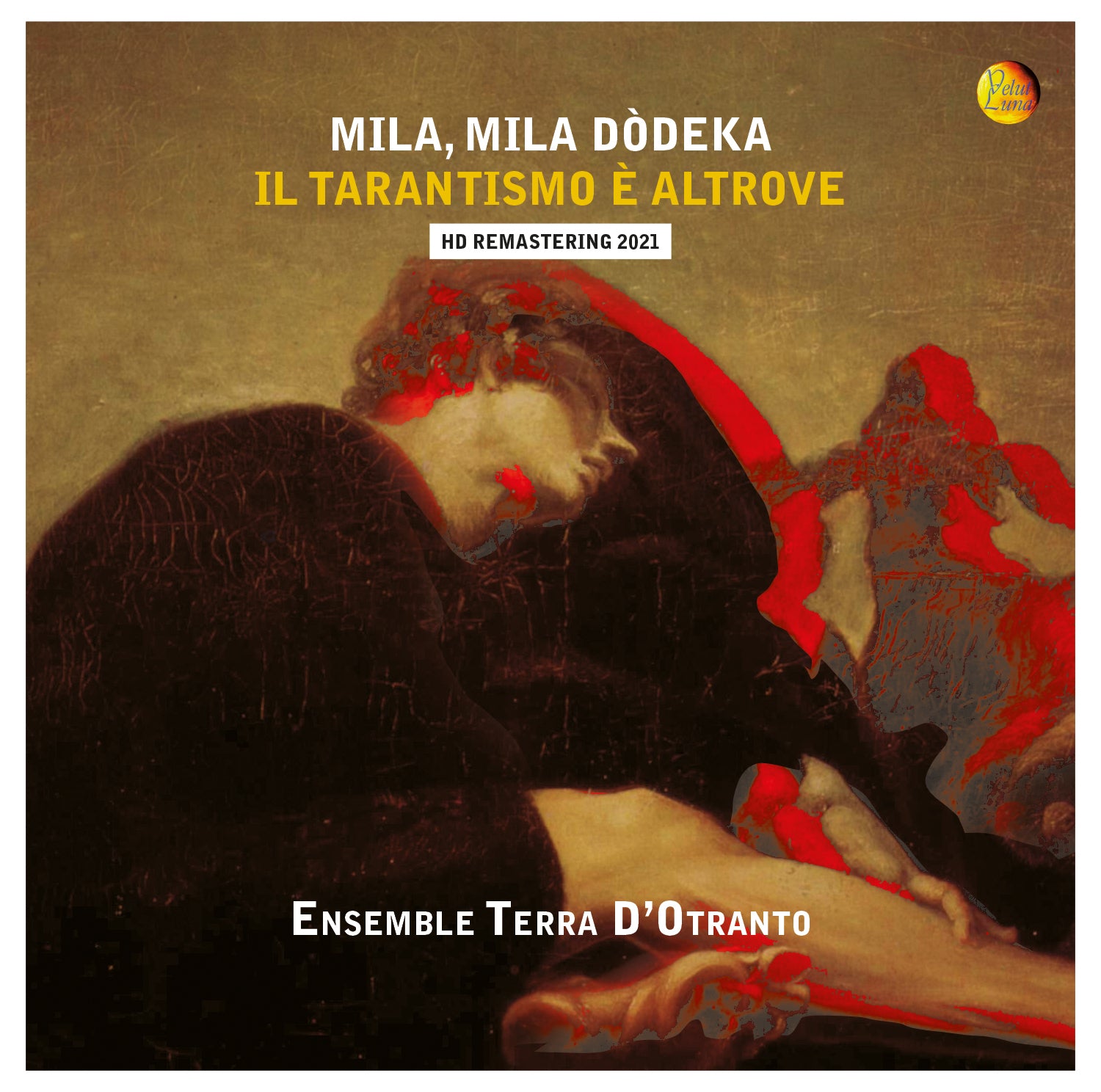Velut Luna
MILA, MILA DODEKA - Ensemble Terra D’Otranto
MILA, MILA DODEKA - Ensemble Terra D’Otranto
Impossibile caricare la disponibilità di ritiro
MILA, MILA DODEKA(CVLD341)
Il Tarantismo è Altrove
1. LamentoTradizione popolare / Arr. D.Longo 1:41
2. Klafsete, Mane (Piangete,Madri) Anononimo, Grecìa Salentina * 0:38
3. S’è ver la tua partita G. Melcarne “Il Montesardo”, dall’op. XI, Napoli 1612 2:44
4. Zoì (Vita) Tradizione popolare / Arr. L. Tarantino-R.Conte 2:11
5. Aria sopra il Fedele Tradizione popolare / Improvvisazioni 2:13
6. Santu Paulu Tradizionale del Salento 0:55
7.Variazioni per tamburello Tradizionale del Salento 1:09
8. Pizzica “de core”(“di cuore”, di corteggiamento) Tradizionale del Salento 3:47
9. La Vergine Maria Tradizionale del Salento 4:07
10. Battaglia di Tarantelle Improvvisazioni su opere di F.Pico e anon. sec. XVII e XVIII 6:40
11. Nia nia nia- Tradizionale della Grecìa Salentina 2:21
12. Rodrigo Martines Anonimo Spagna sec. XVI 2:09 ”Sulle Pene d’Amore”
13. Improvvisazionisu un basso di N. Matteis (sec. XVII ) 1:42
14. Tarantella G. Greco, Napoli sec. XVII 2:01
15. Pizzica Tradizionale del Salento 1:52
16. Passacaglia Tradizione popolare / Improvvisazioni 0:56
17. Antidotum Tarantula e Anonimo sec.XVI, Tradizione popolare / Improvvisazioni 2:36
18. Tarantella tonum phrygiumAnonimo sec.XVI, Tradizione popolare 3:21
19. Mila,Mila Dodeka(Mele,Mele Dodici) (“moroloja”, nenia funebre), Tradizionale del Salento 1:24
20. ‘Ntartieni, Biumbò Tradizione popolare / Arr. L.Tarantino, D.Longo, A.C.Villani, M.Durante 5:44
Tempo totale 50:31
* Prime quattro strofe tratte da un’elegia in terza rima, di circa 200 versi, composta nel 1556 in morte di una fanciulla di nome Katerini (Caterina).
ENSEMBLE TERRA D’OTRANTO
Doriano Longo direzione; violino R.Duke, Londra 1756 viola da braccio Anon. scuola tedesca, fine sec. XVIII
Anna Cinzia Villani voce solista, tamburello (trac. 15)
Nadia Esposito voce recitante, voce, castanuelas (trac. 10)
Rosario Conte chitarra spagnola P.Busato, Padova 1998 copia scuola franco-belga, seconda metà sec. XVII) tiorba (trac. 3, 11, 12): Lourdes Maria Uncilla, El Escorial, Spagna, 2001
Luca Tarantino chitarra spagnola L. Lovadina, Aralde (TV) 1987, modello “Giustiniani” 1681 di A.Stradivari chitarra battente G.De Iaco, Dorfgasse, Svizzera, 1998
Pierluigi Ostuni tiorba Lourdes Maria Uncilla, El Escorial, Spagna, 2001
Mauro Durante tamburi a cornice (trac. 10, 20); castanuelas (trac. 12)
Roberto Chiga tamburi a cornice (trac. 7, 11, 12)
Pippo Ark” d’Ambrosio perccussioni
Ospiti:
Franco Corlianò, voce recitante (Klafsete, Mane)
Gianni de Gennaro, viella (La Vergine Maria)
Nicola Nesta, ud (La Vergine Maria e ‘Ntartieni)
Michele Visaggi, cembalo (Sulle Pene d’Amore)
24 bit 96 kHz original recording at Masseria Torcito – Cannole (Lecce) 2, 3 ottobre 2003
Produzione: Velut luna
ingegnere del suono Marco Lincetto
direttore di registrazione Gianni de Gennaro
editing e mastering Matteo Costa
layout L'image
Pr Francesco Pesavento
Un grazie speciale a:
Abele / Antonio Cassano direttore museo provinciale di Lecce
Sandro Mele, autore dell’opera in copertina
Franco Corlianò e Maria Roca Montinaro depositari della lingua grika
Fernando de Lumè presidente cooperativa sociale “La Sorgente” di Masseria Torcito
“Mila, Mila Dòdeka …” Mele, Mele Dodici…” La mela, come la melacoto-gna e la melagrana, è simbolo di vita e di morte. E’ legata al culto di Persefone, figlia di Demetra, dea della fertilità, rapita nel fiore della giovinezza da Ade il dio dell’oltretomba. Per aver mangiato un seme di melagra-na, Persefone non potrà tornare nel mondo dei vivi, se non per una parte dell’anno. Dividendosi tra la luce e le tenebre, darà origine al ciclo continuo delle stagioni. Una religiosità ellenica i cui miti e riti ancora vivono nella Terra d’Otranto del Seicento, come dimostrano le nenie qui raccolte. Nenie che parlano in griko, lingua di un popolo migrante, dai suoni pregni del dolore del commiato e delle ansie per il viaggio. Lingua sopravvis-suta nel Salento, terra di passaggio, insieme ad altri miti e riti che qui si raccolgono secondo una successione di momenti di vita e di morte. Vita e Morte vanno assieme, in un continuum tra ciò che una toglie ed offre all’altra. Così si passa dal lamento funebre alla ninna nanna, dalla danza sfrenata al lamento per il morso della tarantola. Allo stesso modo una nenia per la dipartita di un bimbo si trasforma in filastroc-ca per i nascituri, dondolati sulle ginocchia dai bium-bò dei nonni e accompagnati dalla voce rassicurante delle madri. Nel riparo di una masseria fortificata, con una piccola cappella sul ciglio di un tratturo che riverbera come una cattedrale, è stato raccolto quanto è venuto fuori da trame sparse e intuizioni del momento. Secondo la pratica barocca,e la tradizione popolare, infatti, ogni esecuzione ha una storia a sé; le note, quando ci sono, sono soprattutto dei segni, delle direzioni. Per il resto esiste il momento, in questo caso quello della registra-zione, dove, a differenza del concerto, ci si rivolge soprattutto a sé stessi. In questa cornice, di raccoglimento e scoperta continua, sono stati riportati in vita, dopo quattro secoli, brani e testi di autori conosciuti e sconosciuti di Terra d’Otranto e delle culture ancora presenti in Terra d’Otranto nel Seicento:il loro lascito è come le dodici mele che la madre consegna al figlio morto come viatico. Ciò che noi ci auguriamo è di saperlo custodire per chi verrà … Ti tuso kosmo presta trapassei”... Perchè questo mondo presto passa!
Abele e Doriano Longo
Share

-

Spedizioni prodotti fisici
Spedizioni gratuite in Europa (UE), a partire da 4 articoli - Richiedere quatozione per i costi di spedizione per i paesi non UE
-

Consegna prodotti digitali
La consegna dei prodotti digitali avverrà direttamente sul sito e riceverai anche una email con il link per il download dei file.
-

Scrivi una recensione
Qui sopra puoi scrivere una recensione sul prodotto che hai acquistato, saremo felici di conoscere la tua opinione.


